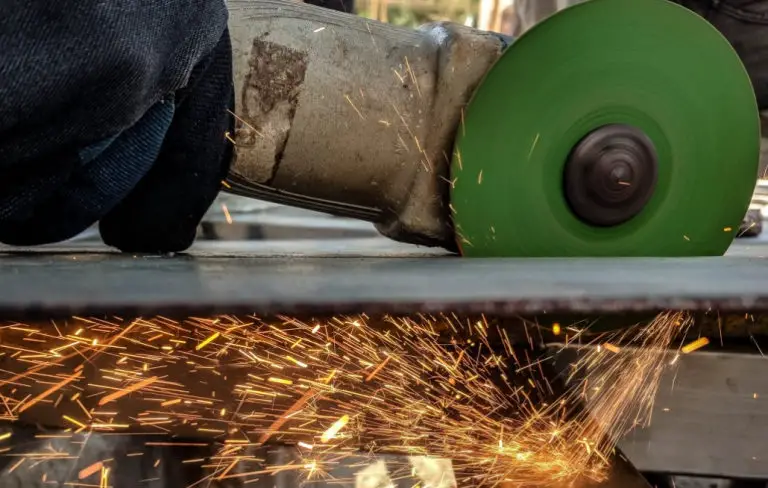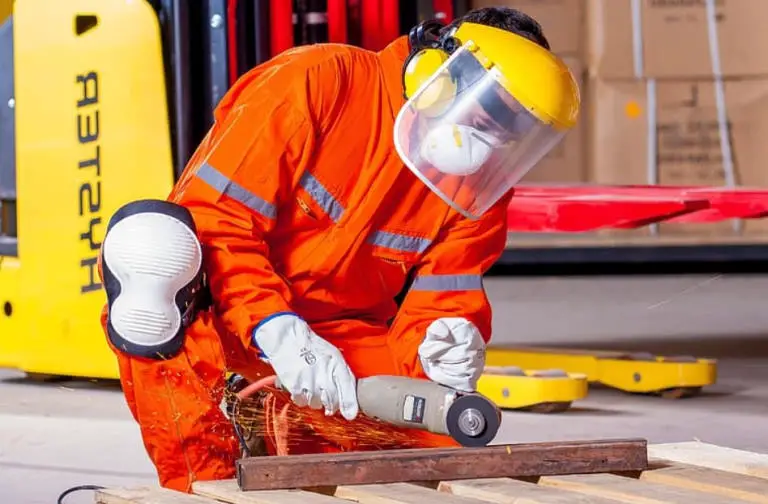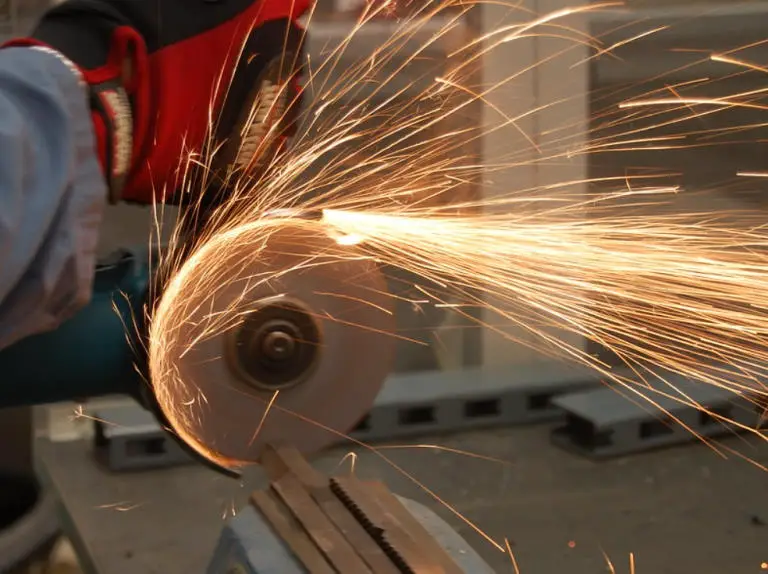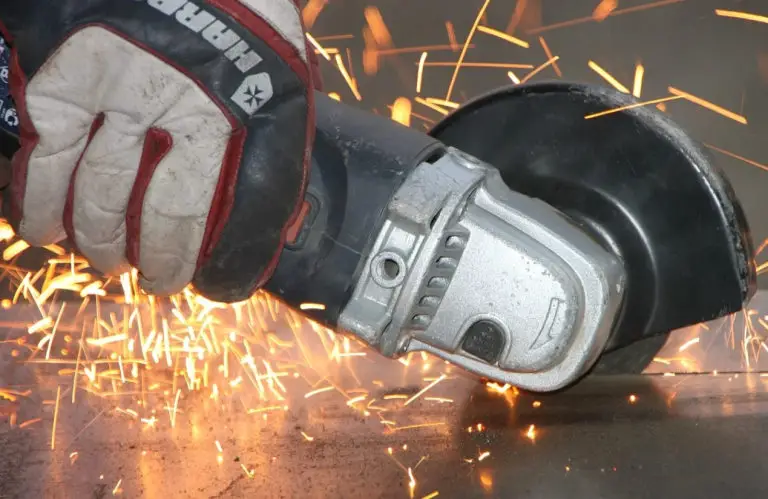Hacksaws used to be a go-to option for cutting metal. However, with the advance of technology, the use of modern power tools can help you complete this task much more efficiently.
Our article will focus on how to use an angle grinder to cut metal since this is a superior choice to carry this kind of project.
Contents
Can Angle Grinder Cut Through Metal?
It’s not exaggerating to say angle grinders specialize in cutting through metals. They can cut a variety of metals, including hard steel, sheet metal, and others. They can also execute various kinds of cuts on those metals, but keep in mind that secure fastening is required for hard metal and the usage of diamond blades is needed for quick cuts.
With the help of an angle grinder, metal cutting and grinder projects can be done rapidly and enjoyably. Nevertheless, remember that this tool can be extremely powerful and dangerous. Therefore, you must take all essential safety measures while using it.

How To Use An Angle Grinder To Cut Metal?
To use your angle grinder to cut metal, you first need to make some preparations and safety gear.
Step 1. Prepare the tools & safety gear
Before starting your metal cutting project, the first thing you should do is to make sure that you have all the necessary tools for it. To ensure your project operate successfully, you may need the following tools:
- An angle grinder;
- A work sample;
- A suitable power source;
- A C-clamp;
- A long power cord;
- Earmuffs;
- The metal workpiece;
- The appropriate metal wheel.
Besides, you should also prepare some personal safety tools for the project. The minimal requirement includes eye goggles, safety boots, a tightly fitting outfit, a pair of work gloves, and a secure floor.
Step 2. Set the angle grinder
Assemble the disk into your grinder. Open the spindle, then insert the metal wheel, and fasten the spindle nut.
Ensure that you’re wearing all the safety gear and the grinder isn’t plugged into a power source.
Step 3. Mark the cuts
Place the metal workpiece on your workbench and secure it with a clamp. After you have attached the metal blade and tested it, draw a rough outline of the design that you wish to cut on the metal surface. Use a scratch awl to mark the workpiece.
If your cutline is straight, mark its two ends and draw a line between them. Otherwise, if it is either a zigzag or a different pattern, outline the bends of the design, then etch straight lines with an awl and highlight the complete pattern.
Step 4. Start cutting
After properly outlining your metal workpiece, you can turn on your angle grinder and start grinding it. Power up the tool and hold it comfortably in both hands. Begin by tapping lightly on the etched line when the blade is spinning.
Hold your machine securely and start gently to make sure that it does not slip out of your hand. Then, follow the marked alignment precisely.
Step 5. Avoid quick change
There’s a danger that if you’re not careful, the grinder can go off the marked cutline. So, you should move it to and fro along the specified cutting line to prevent this from happening.
If you apply more pressure to the grinder when cutting through the metal, your grinding might become less smooth than the beginning.
So, continue the technique until the metal object’s entire thickness has been penetrated. Keep doing this movement till you reach the opposite end of your designated outline. Remember to avoid abruptly altering the grinder’s cutting direction.
Step 6. Finish the cut
When the workpiece is cut through, its chopped edges are sharp and unsafe to handle. Now, use your angle grinder to improve this.
First, detach the grinder’s wheel and replace it with a 40-grit flapper. Then, move it along the freshly cut line’s edge, and the rough edges will be smoothed off.
Safety Tips When Cutting Metal

Always be alert!
Always be on the lookout for unexpected events and those who may enter your worksite. When utilizing dangerous tools like angle grinders, children mustn’t be present.
Don’t cut in wet condition
If you operate your grinder in wet condition, you risk receiving an electric shock. It can frighten you, causing you to let go of your power tool and may injure yourself.
In addition, cordless tools are not waterproof. Therefore, if water gets into their cooling slots, they could be ruined.
Don’t use one hand to hold the object
You shouldn’t handle your grinder single-handedly. If its disc gets stuck in the metal workpiece, the tool is most likely to be wrenched from your hold, posing a risk of a dangerous accident. Even if you’re holding the grinder with both hands, you should still prepare for this risk.
To prevent the motor from burning out, you should release the grinder’s trigger as soon as the wheel binds. If the wheel is still spinning, let it come to a complete stop before removing it.
Don’t force the blade
Yes, as this may cause the grinder to overheat or catch on your workpiece. You should angle the power tool in such a way that sparks fly back between your legs or either of their side.
If the sparks continuously shoot on one spot of your clothes over an extended period of time, your clothes might catch fire. To protect your clothes, you can use a leather apron which is inconvenient, yet simple and efficient.

Don’t walk around with a running grinder
You shouldn’t roam around the working area with a powered-up angle grinder in your hand. It is also true for all power tools since this careless action can seriously injure yourself and other people or your surroundings.
FAQs (Frequently Asked Questions)
1. What size of angle grinders for cutting metal?
A lot of people choose the 4” grinder since this size is ideal for most metals’ daily grinding and cutting requirements.
2. What blade do I need to cut metal with an angle grinder?
You can attach the following discs to your angle grinder to cut metal.
- Diamond blades can cut through cast iron, both non-ferrous & ferrous metals.
- Stainless steel cutting discs are ideal to handle steel and stainless steel. They are especially useful in cutting small cross-sections.
- Multi-cut cutting blades can cut through both ferrous and non-ferrous metals such as stainless steel.
- Cut-off blades/metal cutting discs are suitable for cutting a majority of metals such as a metal pipe, or sheet metal. However, they mustn’t be utilized for grinding projects.
- Thin slitting disks can cut ferrous and non-ferrous metals, as well as stainless steel.
3. How thick of a steel bar can an angle grinder cut?
The steel bar’s thickness that you will be cutting relies on the grinder’s cutting capacity, potential cutting depth, and the size/type of the grinder’s blade.
For thicker and heavier steel such as a steel bar, you’ll need a cutting blade with a thickness ranging from 1.6mm to 2.5mm. However, this hides some disadvantages that you should be aware of. For example, larger disks with a slower speed will increase the friction, which can lead to evidence of discoloration in your finished cut.
So, you can use an alternative power tool for metal cutting tasks, depending on the denseness of the metal workpiece and the cut’s cleanness that you desire. The most common alternative options are metal-cutting circular saws and metal-cutting chop saws.
Final Words
From our article, you can see that it is not too complicated to learn how to use an angle grinder to cut metal. In fact, the power tool is ideal for your metal cutting projects, but keep in mind that people’s safety must always be the top priority. In this respect, you will find our safety tips useful.
